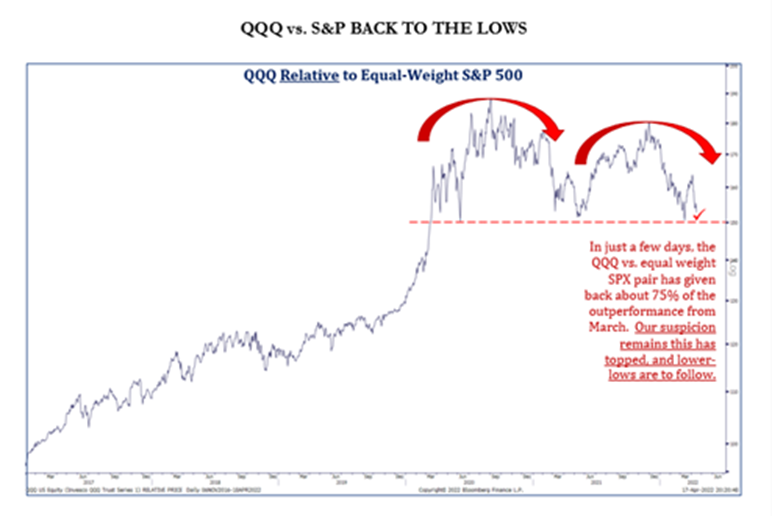- The stock market is starting the week off on the wrong foot again, following the losses from last week. On Friday, the Dow was down over 900 points, its worst day since October 2020.
- It’s a busy earnings week with over 1/3rd of the S&P reporting earnings this week, including the mega cap tech giants like Microsoft, Alphabet, Facebook, Apple and Amazon (Yahoo Finance, April 2022).
- Last week was tough for the markets. US stocks were down 3%, international stocks were down 2%. Value outperformed Growth by over 3% last week (CNBC, April 2022).
- Diversifiers didn’t help. Bonds were down 1%; alts were down 1%; and commodities were down 3% (CNBC, April 2022). Only real estate posted a slight gain (CNBC, April 2022).
- What’s hitting the markets hard is the realization that the Federal Reserve might really be serious about fighting inflation.
- Though it has been more than 20 years since the last 50 basis point hike in the Fed Funds rate, the markets are now expecting 10 hikes (or 2.5% of tightening) in 2022 (CNBC, April 2022).
- One Fed spokesperson last week even mentioned that a 75-basis point hike should be soon.
- Given the long-term average of Fed Funds approximating the rate of inflation, it would make sense.
- Getting closer to 3%, the Ten Year Treasury Yields closed last week at 2.91% (up 8 basis points from the week before). Yields are now back to 2018 levels.
- For the month, the US stock market is now down -6%, international stocks are down 4%, and Value is outperforming Growth by 11% (Yahoo Finance, April 2022).
- Bonds are down 4%, but alts are up 1% and commodities up 4%. Real estate is up 1% (Yahoo Finance, April 2022).
- For the year, US Growth stocks are now down -23% year-to-date, while US Value stocks are up about +1% (Yahoo Finance, April 2022).
- Also, for the year, international is down 9% while the US is down 11% (Yahoo Finance, April 2022). This is despite the messes in Europe and China – and that the US dollar is up about 5% year-to-date (CNBC, April 2022). This is due to growth/tech being under pressure - which is a leading reason why the US outperformed in recent years (CNBC, April 2022).
- Year-to-date performance for Diversifiers: bonds -9%, cash +0%, alts +1, and commodities up 30% (Yahoo Finance, April 2022).
- Recent leadership change in 3-year numbers: commodities are now up 17%/year for the last 3 years (Morningstar Direct, April 2022). US stocks are up 15%/year and US growth stocks are up 16%/year over the same time frames (Morningstar Direct, April 2022).
- Regarding growth investing’s relative performance, here’s a chart from Strategas that shows the NASDAQ (QQQ) (a common but imperfect proxy for growth/tech) divided by the equal-weighted S&P (where every stock in the S&P has the same weight). In short, if this ratio continues to move lower, it suggests small caps will likely outperform (a nice tailwind for active managers) and growth/tech might lag.

- Regarding aggressive growth stock investing, a few days ago there was a study that showed Cathie Wood’s average holding was down over 70% in her flagship fund ARK Innovation ETF (ARK Funds, April 2022). This is not to knock Cathie and ARK, as I understand and appreciate what ARK Invest is doing and applaud their discipline, but it’s a good reminder to investors how fast things can change in the markets.
- For example, most of these stocks, but not all are held in ARKK: Zoom Video is down 82% from its highs, Facebook -52%, Netflix -63%, Teladoc -79%, Roku -77%, Coinbase -59%, Spotify -63%, DraftKings -78%, Robinhood Markets -84%, Roblox -70%, Berkeley Lights -95% and Shopify -65%.
- Something else of note, though it’s related to growth/tech underperforming of late, is that mega caps are underperforming as well. It’s tough to stay “top dog” for long.
- The AAII Investor Sentiment Survey ever so slightly improved last week, but the level of bullish investors (i.e., positive outlook for next 6 months) is still near its lowest levels since 1992!
- Speaking of sentiment, we are working on a new slide for the quarterly OPS Reference Guide that shows how the stock market performs at varying American Association of Individual Investors (AAII) sentiment.
- Repeated from last week: As investment professionals whose mission is to help investors reach their financial goals, this is the time where we really need to step up and fulfill that calling. For us, this is an important time. It’s when we earn our keep. Investors need our counsel. Our education and encouragement on how markets should and could behave. Why their investment plans are appropriate. All of our training and experience was to prepare us for times like these.
- Regarding economic news last week, here are some bullets:
- Labor market looks great, both in terms of trend and level. Another great stat from last week was that we now have the fewest Americans collecting unemployment benefits since 1970.
- Great housing data: March Housing Starts.
- Housing starts surprised to the upside in March, posting the fifth gain in the past six months to hit the fastest pace since 2006.
- Notably, multi-family construction is up 26.2% in the past year while new single-family construction has declined 4.4% (investors see all that rapidly rising rental income).
- Zillow estimates that rental costs for new tenants are up 16.8% in the year ending March 2022 while Apartmentlist.com estimates they have risen 17.1% over the same period, easily exceeding typical gains in the 3.0 - 4.0% range.
- Meanwhile, 30-year mortgage rates are now above 5%, which has pushed some potential buyers back into the rental market.
- The number of homes already under construction are at the highest level since 1973.
- Keep in mind the US needs roughly 1.5 million housing starts per year based on population growth and scrappage (voluntary knockdowns, natural disasters, etc.), and 2021 was the first year in the aftermath of the 2008 - 2009 recession that has crossed that threshold.
- In other recent housing news, the NAHB Housing Index, which measures homebuilder sentiment, declined slightly to 77 in April from 79 in March. While this is the lowest reading in seven months, it’s important to remember that these readings remain near historical highs, still signaling robust optimism from developers
- Ben Carlson’s “Wealth of Common Sense” shares four reasons why the housing market won't crash.
- We don’t have enough housing supply
- No one wants to sell
- Millennials are the biggest demographic in the country
- Consumer balance sheets remain strong
- One-fifth of earnings season is over for S&P 500 companies and according to Factset, 79% have reported actual EPS above estimates, which is above the five-year average of 77%.
- In aggregate, companies are reporting earnings that are 8.1% above estimates, which is below the five-year average of 8.9%.
- The current blended (combines actual results for companies that have reported and estimated results for companies that have yet to report) earnings growth rate for the first quarter is 6.6% today.
- Given the way earnings seasons go though, it’s still reasonable to expect 10%+ when it’s all said and done.
- Outside of earning reports, the biggest number on this week's economic calendar is the first estimate of 1Q GDP. Current consensus view is for 1.0% growth. 4Q21 was 6.9%.
- The Atlanta Fed’s GDPNow estimate for 1Q growth is now 1.3%. This is a slight improvement from the prior week’s 1.1%.
- Other key reports scheduled for this week are March New Home sales and February Case-Shiller house prices.
- ESG Investing has had good growth rates in recent years. How has ESG been embraced on the OPS platform? If we simply take this measure of Net Flows/Latest AUM (arguably one should use average AUM), here are YTD and 1-year numbers (through 3/31):
- Year-To-Date: ESG strategies on OPS have had just under 4% (3.56%) net flows/AUM compared to overall OPS strategies net flows/AUM just being over 3% (3.19%). That qualifies as 12% higher growth.
- 1-Year: ESG strategies on OPS have had just under 30% (29.75%) net flows/AUM compared to overall OPS just being over 20% (20.35%). That qualifies as 46% higher growth.
- ESG flows have slowed due to (1) other overriding investor concerns like inflation and Ukraine, and (2) ESG strategies have growth tilts and growth has underperformed value by 24% (!) as of last Friday.
- Prices fell slightly last week, with Bitcoin back under $40k, falling 2% (Coindesk, April 2022). Ethereum fell nearly 3% to break through $3k, Solana, Cardano, and Avalanche all lost 3-7% (Coindesk, April 2022). Terra’s Luna token was the big winner again with +13% on the week (Yahoo Finance, April 2022).
- Coinbase launched a beta version of its NFT marketplace this week, to mixed reviews. Distinguishing features being more “social” aspects to the platform. The $600+mm Ronin hack in March has now been linked to a North Korean hacker group. Director Ridley Scott will produce an adaptation of a book on the founding of Ethereum.
- Fidelity launched two digital asset ETFs on Thursday, Fidelity Metaverse ETF (FMET) and Fidelity Crypto Industry and Digital Payments ETF (FDIG), both at 0.39% expense ratios which will be among the cheapest in the space (Fidelity, April 2022). Proshares, Direxion, and AXS have all filed for inverse Bitcoin futures ETFs. Defiance also filed for an inverse version of the largest current digital asset ETF, BLOK. And finally, Simplify ETFs filed for a Bitcoin Strategy Risk-Managed Income ETF (MAXI) that will invest in Bitcoin futures contracts with a protective put overlay.
- Alternatives have been outperforming traditional bonds over the last 1-, 3-, 5- and 10-years. On this week’s episode of Orion's The Weighing Machine podcast we interview Yoav Sharon from Driehaus on event-driven investing. Driehaus is an important holding in the 4-Star Destinations Multi-Strategy Fund.
- “Diversification is a concrete nod to the luck and uncertainty inherent in money management and an admission that the future is unknowable.” Dr. Daniel Crosby from a Meb Faber podcast last year.
- Best practices of virtual meetings for financial professionals John Hancock's Portfolio Intelligence podcast.
- Looking for graduation gift ideas? I am. How about Robert Greene's The Daily Laws or Bill Irvine's "The Guide to The Good Life" or Victor Frankl’s Man's Search For Meaning? If you have good ideas, I’m all ears.
- For more resources, please check out the Financial Advisor Success Hub, and as always, please let us know what we can do better at rusty@orion.com or ben.vaske@orion.com.
- For financial advisors to get the Monday Morning Market Insights (aka “Monday Morning Bullets”) delivered straight to their inbox, visit to link Subscribe to Weekly Bullets.
- Have a great week! Invest well and be well.
The CMT Program demonstrates mastery of a core body of knowledge of investment risk in portfolio management. The Chartered Market Technician® (CMT) designation marks the highest education within the discipline and is the preeminent designation for practitioners of technical analysis worldwide. To learn more about the CMT, visit https://cmtassociation.org/.

















